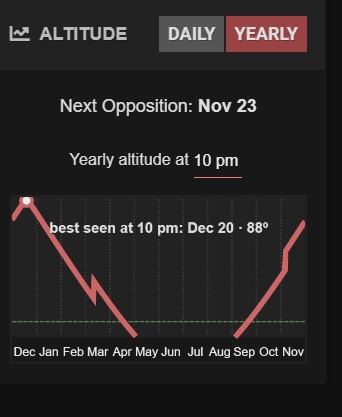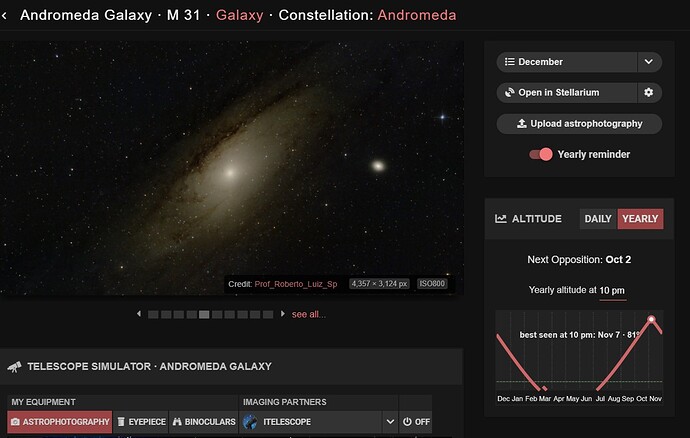Hi Mike,
No problem - its taken me a while to work all this out too …
OK …
In the chart for Andromeda, you can see a ‘Daily’ tab and a ‘Yearly’ tab.
If you click the Daily tab, it will show you a chart of the object’s inclination during the course of one day. In other words, the path it traces across the sky (the traversal) from midnight to midnight. It also displays the transit time for that day. If you hop to the next day, the transit time will be slightly different - it might be earlier or later, depending on where you are and what you’re looking at.
If you click the Yearly tab, it will show a curve of the TRANSIT TIME (not the traversal) on a day-by-day basis over the course of a year. If you pick today’s date, the transit time will be the same as the time displayed in the Daily tab for today’s date (or for any date really).
The ‘Best Seen’ display gives the day and time where the object reaches its highest culmination - ie, the highest point it reaches in the sky - during the course of one year.
So - if you were imaging Andromeda tonight from my place here in Australia, it will transit at 20:04 pm - thats the ‘best seen’ TIME for TODAY when Andromeda is the highest in the sky.
But …
If you wanted the best possible image and were prepared to wait (very risky in this game), you’d pack up everything and come back on 15 November 2022, when Andromeda will be at its maximum annual culmination - the highest it will ever get in the sky from one year to the next. Hence the ‘Annual Reminder’ function.
And …
As with all things astronomical, it gets even more complicated the closer you look. The annual maximum culmination also changes from year to year - so the ‘best seen’ for 2021 is 15 Nov 2021 @ 10pm, but next year it will be something different.
One more thing …
Sometimes, the ‘Best Seen’ takes into account the position of the Earth, as well as the aspect of the object. So for Andromeda, it is at opposition on 2 October, meaning its directly on the other side of the Earth compared to the sun, so viewing will be easier. ‘Best Seen’, if done well, will also take into account the position of the Moon - full moon is not welcome when it comes to imaging feint objects.
One more thing (OK, thats 2 things) …
Sometimes, the ‘Best Seen’ also takes into account the position of your target with respect to other bodies. For example, if you were imaging the moon, you would get a better image when it’s at perigee (closest to the Earth), where it will appear larger - as in the recent Super Moon - as opposed to when it’s at apogee (most distant from the Earth). This matters when imaging planets, but not so much with other things far, far away,
So, to sum it all up …
Transit time gives you the best viewing time for a particular day …
‘Best Seen’ gives you the best viewing time for the year.
Seems easy when I say it like that 
Gary


